
Bal Gangadhar Tilak, endeared as Lokmanya, was an Indian nationalist, teacher, and an independence activist. He was one third of the Lal Bal Pal triumvirate. The British colonial authorities called him "The father of the Indian unrest". He was also conferred with the title of "Lokmanya", which means "accepted by the people as their leader". Mahatma Gandhi called him "The Maker of Modern India".

The Indian Independence Movement, was a series of historic events in South Asia with the ultimate aim of ending British rule in India. It lasted until 1947, when the Indian Independence Act 1947 was passed.

Gopal Krishna Gokhale was an Indian political leader and a social reformer during the Indian independence movement and political mentor of Indian freedom fighter Mahatma Gandhi.

The All-India Muslim League (AIML) was a political party established in Dhaka in 1906 when some well-known Muslim politicians met the Viceroy of British India, Lord Minto, with the goal of securing Muslim interests on the Indian subcontinent.
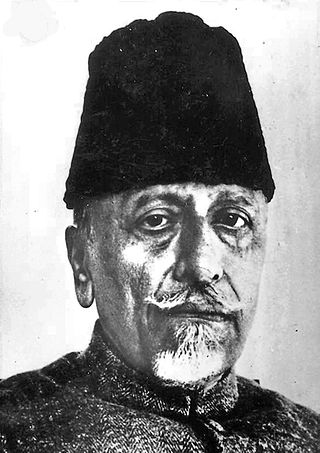
Abul Kalam Ghulam Muhiyuddin Ahmed bin Khairuddin Al-Hussaini Azad ; 11 November 1888 – 22 February 1958) was an Indian independence activist, writer and a senior leader of the Indian National Congress. Following India's independence, he became the First Minister of Education in the Indian government. He is commonly remembered as Maulana Azad; the word Maulana is an honorific meaning 'Our Master' and he had adopted Azad (Free) as his pen name. His contribution to establishing the education foundation in India is recognised by celebrating his birthday as National Education Day across India.

The Indian Home Rule movement was a movement in British India on the lines of the Irish Home Rule movement and other home rule movements. The movement lasted around two years between 1916–1918 and is believed to have set the stage for the independence movement under the leadership of Annie Besant and Bal Gangadhar Tilak to the educated English speaking upper class Indians. In 1920 All India Home Rule League changed its name to Swarajya Sabha.

The Lahore Resolution, also called Pakistan Resolution, was written and prepared by Muhammad Zafarullah Khan and was presented by A. K. Fazlul Huq, the Prime Minister of Bengal, was a formal political statement adopted by the All-India Muslim League on the occasion of its three-day general session in Lahore on 22–24 March 1940. The resolution called for independent states as seen by the statement:
That geographically contiguous units are demarcated regions which should be constituted, with such territorial readjustments as may be necessary that the areas in which the Muslims are numerically in a majority as in the North Western and Eastern Zones of (British) India should be grouped to constitute ‘independent states’ in which the constituent units should be autonomous and sovereign.

The first Partition of Bengal (1905) was a territorial reorganization of the Bengal Presidency implemented by the authorities of the British Raj. The reorganization separated the largely Muslim eastern areas from the largely Hindu western areas. Announced on 16 July 1905 by Lord Curzon, then Viceroy of India, and implemented West Bengal for Hindus and East Bengal for Muslims, it was undone a mere six years later. The nationalists saw the partition as a challenge to Indian nationalism and as a deliberate attempt to divide the Bengal Presidency on religious grounds, with a Muslim majority in the east and a Hindu majority in the west. The Hindus of West Bengal complained that the division would make them a minority in a province that would incorporate the province of Bihar and Orissa. Hindus were outraged at what they saw as a "divide and rule" policy, even though Curzon stressed it would produce administrative efficiency. The partition animated the Muslims to form their own national organization along communal lines. To appease Bengali sentiment, Bengal was reunited by King George V in 1911, in response to the Swadeshi movement's riots in protest against the policy.
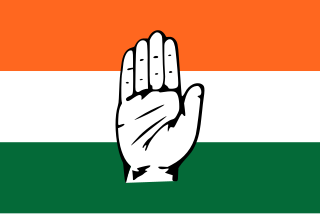
The Indian National Congress was established when 72 representatives from all over the country met at Bombay in 1885. Prominent delegates included Dadabhai Naoroji, Surendranath Banerjee, Badruddin Tyabji, Pherozeshah Mehta, W. C. Banerjee, S. Ramaswami Mudaliar, S. Subramania Iyer, and Romesh Chunder Dutt. The Englishman Allan Octavian Hume, a former British civil servant, was one of the founding members of the Indian National Congress.
A Cabinet Mission went to India on 24 March 1946 to discuss the transfer of power from the British government to the Indian political leadership with the aim of preserving India's unity and granting its independence. Formed at the initiative of British Prime Minister Clement Attlee, the mission contained as its members, Lord Pethick-Lawrence, Sir Stafford Cripps, and A. V. Alexander. The Viceroy of India Lord Wavell participated in some of the discussions.
The Fourteen Points of Jinnah were proposed by Muhammad Ali Jinnah in response to the Nehru report. It basically consisted of four Delhi proposals, the three Calcutta amendments, and demands for the continuation of separate electorates and reservation of seats for Muslims in government services and self-governing bodies. In 1928, an All Parties Conference was convened in reaction to the Simon Commission appointed to discuss parliamentary reform in British India. A committee was set up under Motilal Nehru. That committee prepared a report which is known as "Nehru Report". This report demanded "Dominion Status" for India. Separate electorates were refused and the reservation of seats for the Muslims of Bengal and Punjab was rejected. In this report, not a single demand of the Muslim League was upheld. In reaction to the Nehru Report, Mr. Jinnah was authorized by the League to draft in concise terms the basis of any future constitution that was to be devised for India. Jinnah's aim was to safeguard the interests of Muslims. He, therefore, gave his 14 points. These points covered all of the interests of the Muslims at a heated time and in these 14 points Jinnah stated that it was the "parting of ways" and that he did not want and would not have anything to do with the Indian National Congress in the future. The League leaders motivated Jinnah to revive the Muslim League and give it direction. As a result, these points became the demands of the League and greatly influenced the Muslims' thinking for the next two decades until the establishment of Pakistan in 1947.
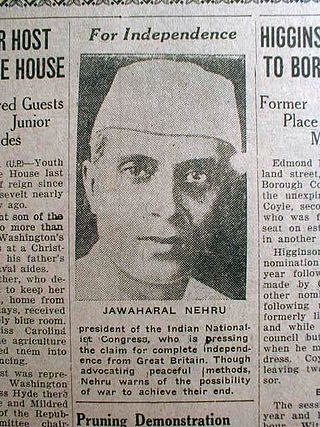
The Declaration of Purna Swaraj was a resolution which was passed in 1930 because of the dissatisfaction among the Indian masses regarding the British offer of Dominion status to India. The word Purna Swaraj was derived from Sanskrit पूर्ण (Pūrṇa) 'Complete', and स्वराज (Svarāja) 'Self-rule or Sovereignty', or Declaration of the Independence of India, it was promulgated by the Indian National Congress, resolving the Congress and Indian nationalists to fight for Purna Swaraj, or complete self-rule/total independence from the British rule
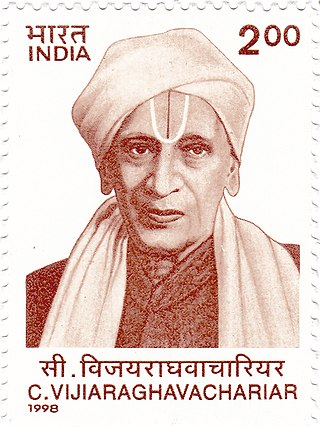
Chakravarti Vijayaraghavachariar was an Indian politician. He rose to prominence following his appeal against the false charges alleging him to have instigated a Hindu – Muslim riot in Salem. The legal battle and eventual victory in proving his innocence earned him the title The Lion of South India.
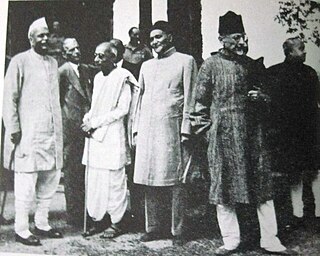
The Simla Conference of 1945 was a meeting between the Viceroy of India, Lord Wavell and the major political leaders of British India at the Viceregal Lodge in Simla. When it was clear that British intended to leave India, they desperately needed an agreement on what should happen when they leave.
Hindu Revolution is a term in Hindu nationalism referring to a sociopolitical movement aiming to overthrow untouchability and casteism to unified social and political community to create the foundations of a modern nation.
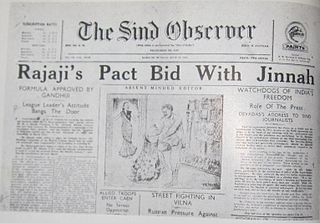
C. Rajagopalachari's formula was a proposal formulated by Chakravarti Rajagopalachari to solve the political deadlock between the All India Muslim League and the Indian National Congress on the independence of British India. The League's position was that the Muslims and Hindus of British India were of two separate nations and henceforth the Muslims had the right to their own nation. The Congress, which had predominantly Hindu members and opposed to the idea of partitioning the Subcontinent. With the advent of the Second World War the British administration sought to divide the Indian political elite into two factions so as to make sure that the Indian independence movement does not make large progress, taking advantage of the war.
The Responsive Cooperation Party was a political party operating in the Indian independence movement and was established by M. R. Jayakar, B. S. Moonje, N. C. Kelkar and others. The party was a splinter from the Motilal Nehru-led Swaraj Party, which was further split by the formation of the Independent Congress Party and the Nationalist Party. The Responsive Cooperationists had become opposed to the concept of non-cooperation with the government of the British Raj and Jayakar's move away from the Swaraj Party was evident by October 1925. The concept of responsive cooperation predates the party and was coined by Joseph Baptista, before being taken up by Bal Gangadhar Tilak, of whom Kelkar was a follower, around 1919.

Muhammad Ali Jinnah was a barrister, politician and the founder of Pakistan. Jinnah served as the leader of the All-India Muslim League from 1913 until the inception of Pakistan on 14 August 1947, and then as the Dominion of Pakistan's first governor-general until his death.
The Surat Split was the splitting of the (INC) Indian National Congress into two groups - the Moderates and Radicals aka extremists - at the Surat session in 1907.
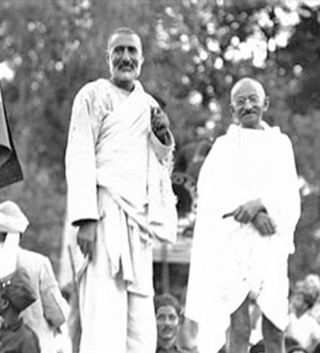
Hindu–Muslim unity is a religiopolitical concept in the Indian subcontinent which stresses members of the two largest faith groups there, Hindus and Muslims, working together for the common good. The concept was championed by various persons, such as leaders in the Indian independence movement, namely Mahatma Gandhi and Khan Abdul Ghaffar Khan, as well as by political parties and movements in British India, such as the Indian National Congress, Khudai Khidmatgar and All India Azad Muslim Conference. Those who opposed the partition of India often adhered to the doctrine of composite nationalism.


















